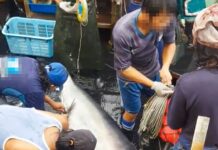
By Liz Anyango
Nairobi, Kenya: The Conservation Alliance of Kenya has appealed to the National Environment Tribunal (NET) to halt the construction of a segment of the Mega Mau Mau Road project that cuts at the heart of the critical Abedere National Park and Forest Reserve.
The contentious approval of the construction of the highway through the wilderness activity zone threatens to split the crucial water tower in two, sparking a frantic race against time to preserve its ecological integrity.
Speaking at a press conference in Nairobi, Nyaguthie Chege, Chair of the Green Belt Movement, sounded the alarm over the perilous course of action surrounding the proposed Ndunyu Njeru-Ihithe highway. Speaking on behalf of The Conservation Alliance of Kenya (CAK) and its 73 member organizations, she underscored the alarming implications of the road project trajectory.

Kenya Wildlife Service personnel and visitors, not for public use. However, there are plans
to upgrade it into a mega highway as part of the ambitious Government of Kenya Mau-Mau
Road project, linking Nyeri and Nyandarua counties
“We wish to highlight the detrimental impact of the proposed Ndunyu Njeru – Ihithe highway, which will cut through the very heart of the Aberdare National Park and Forest Reserve, including its most sensitive areas such as the wilderness activity zone. The Aberdare ecosystem is crucial for economic development and our well-being. It is one of the five main water towers providing water to millions around Aberdare and beyond. Nairobi, our capital city, relies heavily on this water source, among other urban centers.”
Chege emphasized that building a road poses a significant risk of irreversible harm to the vital ecosystem.
“This ecosystem is a sanctuary for a wide variety of rare and endangered animals, such as the black rhino, and the mountain bongo, and boasts one of the largest elephant populations in the country,” Nyaguthie highlighted.
She warned that the proposed road would disrupt the natural movement of wildlife, increasing the risk of tragic accidents involving vehicles and wildlife resulting in injuries, deaths, and animal road kills.
CAK’s legal counsel, Brian Onderi, highlighted the dissatisfaction of his clients with NEMA’s decision to approve the construction of the Mau-Mau Road saying that the alliance has valid grounds for contesting the decision and stressed the importance of utilizing legal mechanisms provided for in the law to address such concerns.
“I have officially lodged an appeal with the National Environment Tribunal (NET) on behalf of CAK and we are confident in NET’s ability to impartially consider all issues at hand for the betterment of the country’s environmental welfare.”

The Mega Mau- Mau Road project has faced staunch opposition from environmental groups, who argue that an alternative road should be considered by the government.
“Our water in Nairobi is coming from two main dams Sasumwa and Ndakaini and the catchment of those dams is actually the Aberdare. We do not want a road that crosses the Aberdare that will interfere with the water catchment function of that ecosystem. On top of that, the Aberdare National Park is very rich in biodiversity and it has also a very large population of elephants. 10% of Kenya’s elephant population is found in the Aberdare ecosystems. We have close to 3600 elephants in that ecosystem.
It is a protected area in Kenya with the highest density of elephants. 2.1 elephants per square kilometer. This road will cross and cut into two the Aberdare National Park. We will have the conflict between wildlife and road users. The alternative road lies outside the Aberdare Electric fence. And this means that there will be no conflict with wildlife.” Noted Christian Lambrecht – Executive Director, Rhino Ark.
“The road project, furthermore, is socially and economically not viable. Scientists from the universities of Nairobi, Oxford, and Amsterdam have assessed that the proposed road through the Aberdare Forest Reserve and National Park will not bring people closer to a tarmac road or reduce travel time to markets. In fact, it will only be open during the day, between 6 am and 6 pm as per park regulations. These findings have also been presented to the government. Sadly, the Government did not consider this alternative road and decided to approve a road with no proven socio-economic benefits and serious and irreversible negative impacts on one of the most vital natural ecosystems of this country” Added Chege.
“The primary objective of this road is to connect Nyeri County with Nyandarua County. However, an alternative route exists, which not only minimizes environmental impact, because it is outside the park’s electric fence, but also offers greater socio-economic and connectivity benefits to a larger population in Nyandarua, Nyeri, and neighboring counties. The Ndaragwa – Pesi – Shamata – Kariamu route also provides a shorter connection to the two-county headquarters, Olkalau, and Nyeri, 110 kilometers compared to the proposed road’s 115 kilometers.” Lambrecht who we interviewed before the appeal, unpacked the pros and cons of the proposed road , noting that the alternative route is also significantly cheaper to construct, it will cost one-third less at 1.5 Billion compared to the proposed 4.4 Billion shillings.” Lambrecht highligted.
Reiterating that the group is not against development and connectivity but called for sustainable road infrastructure.
“We are not saying that it is development versus conservation, but we are saying that we can actually have both. It is not a choice that we have to make, but there are better options and better alternatives. So why would we be competing with wildlife? Does wildlife have their space? The habitat has its space and we have a place to develop. So we are not saying no to development. We are not saying no to a road and connecting people. But we are saying there are better alternatives to that connection, ” Nancy Githaiga – Kenya Country Director, African Wildlife Foundation, emphasized.
In a resounding plea to the government, the alliance urged the Kenyan government to take a very close look at the alternative proposed and to further cancel the National Environment Management Authority (NEMA) license that approved the construction of the road.
“We have to ask ourselves what it takes to reverse the impacts of man. It is expensive when we look at the resources, but cheaper to conserve, to avoid a situation like Lake Olbolosat which would have started 20 years ago. We failed Lake Olbolosat. So the moral of the story is let us protect Aberdare so that we do not write a second failure within the same ecosystem.” Steve Itela – CEO, of the Conservation Alliance of Kenya.
Christine Mwangi, Regional Coordinator of the Africa Sustainable Investments & Infrastructure Programme at the World Wide Fund for Nature – Kenya (WWF-Kenya), added that “An alternative connectivity solution will ensure that the socio-economic benefits are provided sustainably and also the critical ecosystem is preserved. Because What happens in the Aberdare does not stay in the Aberdare, making the preservation of this critical ecosystem, my business, Your business, and our business. When nature is healthy, the nation is wealthy. A healthy Aberdare means the communities living near it, far and beyond will enjoy the benefits.”













